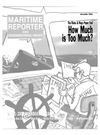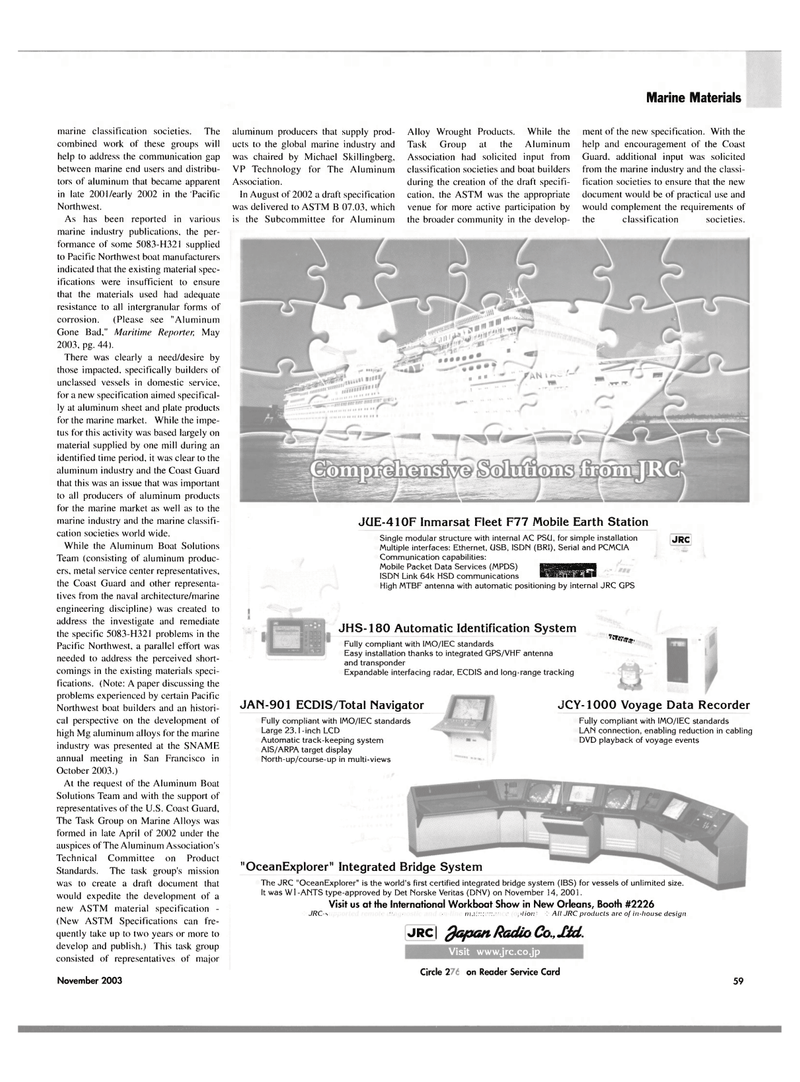
Page 62: of Maritime Reporter Magazine (November 2003)
Read this page in Pdf, Flash or Html5 edition of November 2003 Maritime Reporter Magazine
Marine Materials marine classification societies. The combined work of these groups will help to address the communication gap between marine end users and distribu- tors of aluminum that became apparent in late 2001 /early 2002 in the Pacific
Northwest.
As has been reported in various marine industry publications, the per- formance of some 5083-H321 supplied to Pacific Northwest boat manufacturers indicated that the existing material spec- ifications were insufficient to ensure that the materials used had adequate resistance to all intergranular forms of corrosion. (Please see "Aluminum
Gone Bad," Maritime Reporter, May 2003, pg. 44).
There was clearly a need/desire by those impacted, specifically builders of unclassed vessels in domestic service, for a new specification aimed specifical- ly at aluminum sheet and plate products for the marine market. While the impe- tus for this activity was based largely on material supplied by one mill during an identified time period, it was clear to the aluminum industry and the Coast Guard that this was an issue that was important to all producers of aluminum products for the marine market as well as to the marine industry and the marine classifi- cation societies world wide.
While the Aluminum Boat Solutions
Team (consisting of aluminum produc- ers, metal service center representatives, the Coast Guard and other representa- tives from the naval architecture/marine engineering discipline) was created to address the investigate and remediate the specific 5083-H321 problems in the
Pacific Northwest, a parallel effort was needed to address the perceived short- comings in the existing materials speci- fications. (Note: A paper discussing the problems experienced by certain Pacific
Northwest boat builders and an histori- cal perspective on the development of high Mg aluminum alloys for the marine industry was presented at the SNAME annual meeting in San Francisco in
October 2003.)
At the request of the Aluminum Boat
Solutions Team and with the support of representatives of the U.S. Coast Guard,
The Task Group on Marine Alloys was formed in late April of 2002 under the auspices of The Aluminum Association's
Technical Committee on Product
Standards. The task group's mission was to create a draft document that would expedite the development of a new ASTM material specification - (New ASTM Specifications can fre- quently take up to two years or more to develop and publish.) This task group consisted of representatives of major
November 2003 aluminum producers that supply prod- ucts to the global marine industry and was chaired by Michael Skillingberg,
VP Technology for The Aluminum
Association.
In August of 2002 a draft specification was delivered to ASTM B 07.03, which is the Subcommittee for Aluminum
Alloy Wrought Products. While the
Task Group at the Aluminum
Association had solicited input from classification societies and boat builders during the creation of the draft specifi- cation, the ASTM was the appropriate venue for more active participation by the broader community in the develop- ment of the new specification. With the help and encouragement of the Coast
Guard, additional input was solicited from the marine industry and the classi- fication societies to ensure that the new document would be of practical use and would complement the requirements of the classification societies.
JGE-410F Inmarsat Fleet F77 Mobile Earth JStation
Single modular structure with internal AC PS(J, for simple installation
Multiple interfaces: Ethernet, (JSB, ISDN (BRI), Serial and PCMCIA
Communication capabilities:
Mobile Packet Data Services (MPDS) ^^^^MHH
ISDN Link 64k HSD communications •WPJwWBi
High MTBF antenna with automatic positioning by internal JRC GPS
JRC
JHS-180 Automatic Identification System
Fully compliant with IMO/1EC standards
Easy installation thanks to integrated GPS/VHF antenna and transponder
Expandable interfacing radar, ECD1S and long-range tracking ""Itfitf,
JAN-901 ECDIS/Total Navigator
Fully compliant with IMO/IEC standards
Large 23.1 -inch LCD
Automatic track-keeping system
A1S/ARPA target display
North-up/course-up in multi-views
JCY-1000 Voyage Data Recorder
Fully compliant with IMO/IEC standards
LAN connection, enabling reduction in cabling
DVD playback of voyage events
Visit www.jrc.co.jp
Circle 208 on Reader Service Card 59
JRC[
The JRC "OceanExplorer" is the world's first certified integrated bridge system (IBS) for vessels of unlimited size.
It was Wl-ANTS type-approved by Det Norske Veritas (DNV) on November 14, 2001.
Visit us at the International Workboat Show in New Orleans, Booth #2226
JRC supported remote diagnostic and on-line maintenance (option) •:• Ait JRC products are of in-house design flopon Radio Co., lid. "OceanExplorer" Integrated Bridge System

 61
61

 63
63
